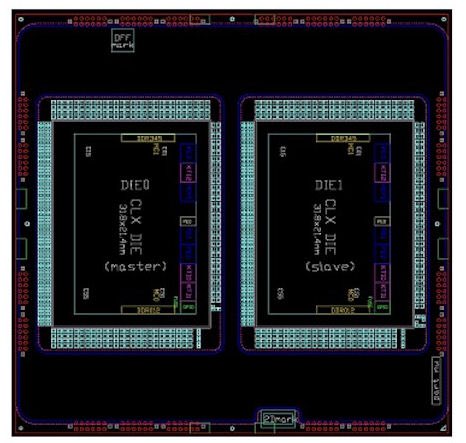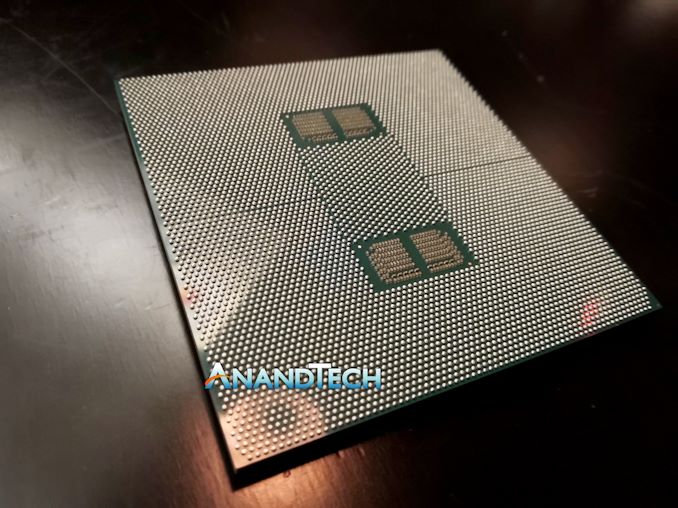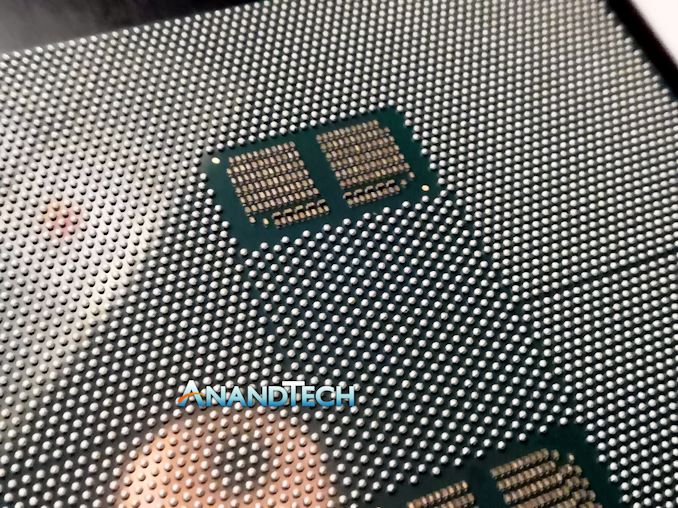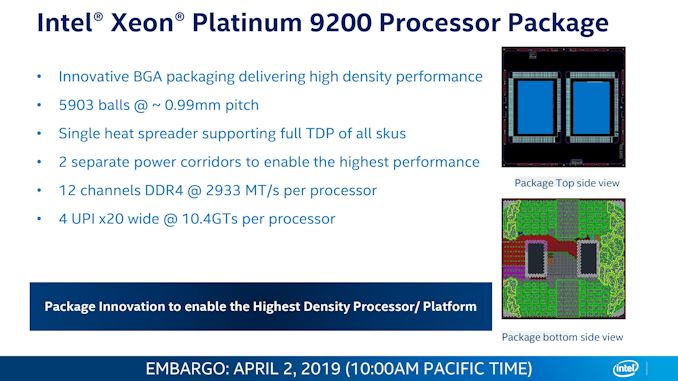Hands on with the 56-core Xeon Platinum 9200 CPU: Intel’s Biggest CPU Package Ever
by Ian Cutress on April 8, 2019 11:00 AM EST
When Intel announced the new Cascade Lake family as officially launched last week, it added a new product segment to its portfolio – the ‘Advanced Performance’ or AP. These come in the form of the Xeon Platinum 9200 family, and feature two of Intel’s high-end processors within a single package, offering double the cores and double the memory in a much denser environment. These processors are focusing purely on density, and are BGA only so they will only be sold as complete systems by OEMs, who actually buy them from Intel and make modifications. We had the opportunity to hold one of these big CPUs and take some pictures.
The package measures 76.0 x 72.5 mm, making it Intel’s largest CPU based* package ever, beating out the old Intel Pentium Pro, which was 67.6 x 62.5 mm, and AMD’s EPYC package, which is 75.4 x 58.5 mm.
Inside the package is two XCC enabled silicon die, one designated a master, and one a slave. The die themselves are ~694mm2 each.
The Biggest Baller In The Park
The socket is officially called FCBGA5903, which stands for flip-chip ball-grid array 5903, with 5903 being the number of contacts or ‘balls’ on the underside which goes onto the motherboard, much like an embedded chip. By contrast, AMD’s EPYC chip has 4094 pins. The reason for all these contacts are mostly in the memory: as this Platinum 9200 processor has twelve memory channels, these all require pins. There are also some more for power, as the TDP for the 56-core version is 400W.
To begin, Intel is offering four different types of Platinum 9200:
| Intel Xeon Platinum 9200 Family (Cascade Lake AP) |
||||||
| AnandTech | Cores | Base Freq |
Turbo Freq |
L3 Cache |
TDP | Price |
| Platinum 9282 | 56 C / 112 T | 2.6 GHz | 3.8 GHz | 77.0 MB | 400 W | head |
| Platinum 9242 | 48 C / 96 T | 2.3 GHz | 3.8 GHz | 71.5 MB | 350 W | shoulders |
| Platinum 9222 | 32 C / 64 T | 2.3 GHz | 3.7 GHz | 71.5 MB | 250 W | knees |
| Platinum 9221 | 32 C / 64 T | 2.1 GHz | 3.7 GHz | 71.5 MB | 250 W | toes |
In terms of weight, the processor is definitely around 200-300g, or half a pound. This was measured very scientifically by comparing it in my hands to the weight of my heaviest phone, and then comparing it to two phones. The chip certainly has some hefty bulk, but given that it is a BGA design, it’s unlikely that even people using the chip will ever hold it.
If we look side on to the design, we can see that the package actually has three distinct layering stages (five, if you include the caps). The light brown and dark brown layering totals up to 18 layers (recorded by eye, hard to see in difficult light), and the dark brown layers are clearly double the thickness of the light brown layers, which might indicate that these are the power planes of the package. Normally we see processors with anywhere from 8-12 layers total, so this is another step up above that.
A close up of the ball array shows the fine pitch between the contacts. The capacitors on the underside are extremely tiny in comparison to other CPUs - I mean really small. Each of these corners has 87 capacitors, making for a total of 348.
Pricing for this family of processors is not expected to be disclosed. Intel has stated that as they are selling these chips as part of barebones servers to OEMs that they will unlikely partition out the list pricing of the parts, and expect OEMs to cost them appropriately. Given that the new high-end Intel Xeon Platinum 8280L, with 28 cores and support for 4.5 TB of memory, runs just shy of ~$18k, we might see the top Xeon Platinum 9282 be anywhere from $25k to $50k, based on Intel margins, OEM margins, and markup.
*Intel may have FPGA products that exceed this size, mainly due to HBM and other chiplets on board.
Related Reading
- Intel's Enterprise Extravaganza 2019 Roundup
- Intel Xeon Scalable Cascade Lake: Now with Optane!
- Intel Agilex: 10nm FPGAs with PCIe 5.0, DDR5, and CXL
- Intel Columbiaville: 800 Series Ethernet at 100G, with ADQ and DDP
- Intel Launches the Xeon D-1600 Family: Upgrades to Xeon D-1500
- Lenovo’s New Cascade Lake ThinkSystem Servers: Up to 8 Sockets with Optane
- Dell PowerEdge Updates: Upgrade to Cascade Lake and Optane
- Supermicro Calvinballs Into Cascade Lake: Over 100 New and Updated Offerings























66 Comments
View All Comments
HStewart - Monday, April 8, 2019 - link
Do you really think desktop or even server machines are highest volume customers - you can't just go off Amazon selling list - the larger market has significantly change or the last decade and has gone mobile.This chip is specialize market and I would expect buyers upgrade there system on compatibility with previous system and desiring more horsepower and storages - extremely small percentage would use them for gam\ing if any.
HStewart - Monday, April 8, 2019 - link
Any chance for some performance analysis. It would be interesting to compare it dual cpu 28 environment. Or compare the 9222 again a dual cpu 16 environment. it would be nice for single 28 core again dual 14 core Just wanting to see if environment has effect.Combine of cpu's in a package is not new - it was attempted in Pentium D and seems pretty popular now days - but I have some concerns CPU are involving into just adding more core instead on performance per core functionality.
Ian Cutress - Monday, April 8, 2019 - link
We're trying to get access to a system for testing.HStewart - Monday, April 8, 2019 - link
Understand such a new expensive system could be hard - but it would be nice especially on this designed to know overhead on it doing multiple cpu's vs multiple cpu and such. You do such a good job in technical analysis.mooninite - Monday, April 8, 2019 - link
We can finally encode AV1 in real time!GreenReaper - Monday, April 8, 2019 - link
I'd rather wait for an AV1 hardware codec - perhaps forthcoming with Navi? (I can dream!)I don't mind waiting until 2020 when I can get it with hopefully a 7nm APU, since I'd be buying a system which I hope to use for the next decade, like the laptop I'm on now.
AVC/H.264 lasted surprisingly well, but we're reaching the end of the road there - it's just too inefficient for 4K+ - and I don't see HEVC/H.265 getting the same support online, while AV1 looks like the web's next format.
DigitalFreak - Monday, April 8, 2019 - link
Will be interesting to see how this processor stacks up against a 64 core EPYC @ a guesstimated $5 - 7k.twtech - Monday, April 8, 2019 - link
It seems to me like the only exists because of Epyc 2. It's a stopgap measure to say that, "hey, we have very high core count processors too!""Nevermind of course the fact that ours cost almost 10x as much and use enormous power."
HStewart - Monday, April 8, 2019 - link
This reminds me so much of frequency war days and in the end that didn't matter to much. What matter is the architexture and not speed of CPU. This was of course Pentium 4 days and Intel learn from it and with I series.Now we see this in too sides - number of cores and nm size. But of which in the long run will not matter has much.
I know it depends on what you using it for, but it would be interesting to know if point when adding more cores adds nothing to system.
FreckledTrout - Monday, April 8, 2019 - link
It's very much like that. Recall AMD and Intel were on the same process node with Intel eventually taking the lead. This time around Intel is at a disadvantage.